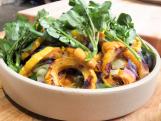Brew a Better Cup of Coffee... Part 2

Whether you're looking to get serious about your cup o' joe, or just want to sip on something richer and more full-bodied, you don't have to leave home to make it happen. Good things may not always come easy, but brewing a better cup of coffee can.
Last week we talked about how the right equipment and fresher beans lead to a better cup of coffee. Today, it's all about the brew.
You might save a few minutes each morning buying pre-ground coffee beans, but you lose big time on flavor — pre-ground beans don't retain their flavor nearly as well as whole ones. Once ground beans come into contact with oxygen, the flavor will immediately begin to fade. It's why bags of freshly ground beans smell amazing the first time they're opened, but loose their aroma soon afterward. By buying your beans whole and grinding them to order, you'll minimize the oxidation process and ensure those beans don't lose any of their bite.

Because different brewing methods expose ground coffee to hot water in different ways, and for different periods of time, it's important to grind your coffee according to the brewing method you choose.
Infusion methods like the French press steep your coffee for a longer period of time, so you want to grind your coffee on the courser side. If you go too fine, your brew will end up on the bitter side and have bits of coffee sediment sitting at the bottom. For drip and pour-over methods like the Chemex coffeemaker, aim for a medium-fine to medium grind size. (Fine grinds are used for Turkish coffee and stove-top espressos.)

When shopping for a coffee grinder, you'll come across two main types. Blade Grinders work by chopping the beans with spinning blades. They don't create a uniform grind size, and for this reason I do not recommend them. If you're stuck with one, be careful not to overgrind. A couple short pulses should do it.
Burr grinders work by cutting the beans between moving wheels. Burr grinders allow you to set the grind size you want, and produce a uniformly ground bean. This means a smoother-tasting cup of coffee. These are on the more expensive side, but the result is superior. If you can, opt for a burr grinder.

Many folks just eyeball the ratio of coffee to water, but getting more specific here will also get you closer to a better cup. Different roasts call for different ratios, so don't be shy about talking to your roaster for a recommendation.
A good rule of thumb to start with is 4 tablespoons of coffee for every 12 ounces of water when using a French press, and 4 1/2 tablespoons of coffee for every 12 ounces of water with a Chemex. From there, you can adjust according to your taste.
For the very best results, weigh your coffee with a scale. Volume can be imprecise—different coffees have different densities, and not every spoon is the same. When weighing, begin with 21 grams of coffee for every 12 ounces of water when using a French Press, and 24 grams of coffee for every 12 ounces of water with a Chemex. If that's too strong, use less coffee, and if it isn't quite strong enough, add a bit more.
The optimal temperature for brewing coffee is between 198-204°F. If you're using a drip, you'll almost get there; one of the real advantages to brewing with a French press or Chemex is that it's easy to get within the ideal temperature range. Just bring the water to a boil, and then let it cool for just under a minute. It only takes about 30-45 seconds for the water to fall within the optimal 198-204°F range, and you're ready to pour.
For a French press, allow 4 minutes of steep time. The brewing time for a Chemex is 3-4 minutes.

Read last week's post on storing beans and choosing a coffeemaker.
Ken Nye, owner of Ninth Street Espresso, is one of New York City’s most prominent coffee people. Since opening his specialty coffee store in 2001, it has expanded to three separate locations and become a mainstay for coffee purists. Ken believes in elevating the standards of coffee, while shedding it’s often snobby reputation.












